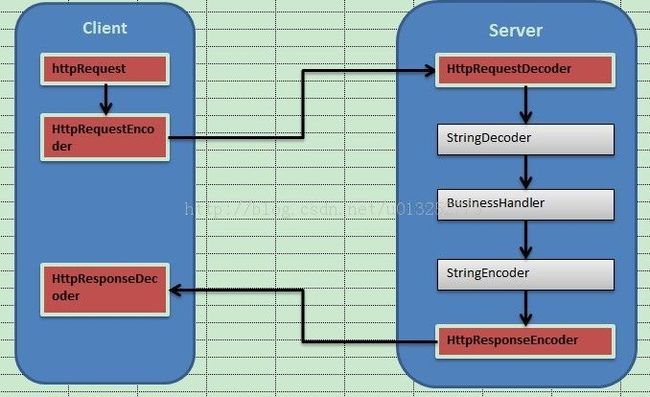netty 学习 (4)混合使用coder和handler
该例子模拟一个Server和Client,两者之间通过http协议进行通讯,在Server内部通过一个自定义的StringDecoder把httprequest转换成String。Server端处理完成后,通过StringEncoder把String转换成httpresponse,发送给客户端。具体的处理流程如图所示:
其中红色框中的Decoder、Encoder及request都是Netty框架自带的,灰色框中的三个类是我自己实现的。
引入jar包:
用到的log4j.xml:
<?xml version="1.0"?>
<!DOCTYPE log4j:configuration SYSTEM "log4j.dtd">
<log4j:configuration xmlns:log4j="http://jakarta.apache.org/log4j/">
<appender name="CONSOLE" class="org.apache.log4j.ConsoleAppender">
<layout class="org.apache.log4j.PatternLayout">
<param name="ConversionPattern" value="[%-5p] [%d] [%t] [%c] %m%n"/>
</layout>
</appender>
<appender name="FILE" class="org.apache.log4j.DailyRollingFileAppender">
<param name="File" value="./log/netty.log"/>
<layout class="org.apache.log4j.PatternLayout">
<param name="ConversionPattern" value="[%-5p] [%d] [%t] [%c] %m%n"/>
</layout>
</appender>
<appender name="FILE_ERR" class="org.apache.log4j.DailyRollingFileAppender">
<param name="File" value="./log/netty_err.log"/>
<param name="Threshold" value="ERROR" />
<layout class="org.apache.log4j.PatternLayout">
<param name="ConversionPattern" value="[%-5p] [%d] [%t] [%c] %m%n"/>
</layout>
</appender>
<logger name="io.netty" additivity="false">
<level value="INFO,DEBUG" />
<appender-ref ref="FILE" />
<appender-ref ref="FILE_ERR" />
<appender-ref ref="CONSOLE" />
</logger>
<logger name="com.yao" additivity="false">
<level value="INFO,DEBUG" />
<appender-ref ref="FILE" />
<appender-ref ref="FILE_ERR" />
<appender-ref ref="CONSOLE" />
</logger>
<root>
<level value="debug"/>
<appender-ref ref="FILE"/>
<appender-ref ref="CONSOLE"/>
<appender-ref ref="FILE_ERR" />
</root>
</log4j:configuration>
Server端的类有:Server StringDecoder BusinessHandler StringEncoder四个类。
1、Server 启动netty服务,并注册handler、coder,注意注册的顺序:
package com.yao.codehandler;
import io.netty.bootstrap.ServerBootstrap;
import io.netty.channel.ChannelFuture;
import io.netty.channel.ChannelInitializer;
import io.netty.channel.ChannelOption;
import io.netty.channel.EventLoopGroup;
import io.netty.channel.nio.NioEventLoopGroup;
import io.netty.channel.socket.SocketChannel;
import io.netty.channel.socket.nio.NioServerSocketChannel;
import io.netty.handler.codec.http.HttpRequestDecoder;
import io.netty.handler.codec.http.HttpResponseEncoder;
// 测试coder 和 handler 的混合使用
public class Server {
public void start(int port) throws Exception {
EventLoopGroup bossGroup = new NioEventLoopGroup();
EventLoopGroup workerGroup = new NioEventLoopGroup();
try {
ServerBootstrap b = new ServerBootstrap();
b.group(bossGroup, workerGroup).channel(NioServerSocketChannel.class)
.childHandler(new ChannelInitializer<SocketChannel>() {
@Override
public void initChannel(SocketChannel ch) throws Exception {
// 都属于ChannelOutboundHandler,逆序执行
ch.pipeline().addLast(new HttpResponseEncoder());
ch.pipeline().addLast(new StringEncoder());
// 都属于ChannelIntboundHandler,按照顺序执行
ch.pipeline().addLast(new HttpRequestDecoder());
ch.pipeline().addLast(new StringDecoder());
ch.pipeline().addLast(new BusinessHandler());
}
}).option(ChannelOption.SO_BACKLOG, 128)
.childOption(ChannelOption.SO_KEEPALIVE, true);
ChannelFuture f = b.bind(port).sync();
f.channel().closeFuture().sync();
} finally {
workerGroup.shutdownGracefully();
bossGroup.shutdownGracefully();
}
}
public static void main(String[] args) throws Exception {
Server server = new Server();
server.start(8000);
}
}
package com.yao.codehandler;
import io.netty.channel.ChannelHandlerContext;
import io.netty.channel.ChannelInboundHandlerAdapter;
import io.netty.handler.codec.http.HttpContent;
import io.netty.handler.codec.http.HttpHeaders;
import io.netty.handler.codec.http.HttpRequest;
import org.apache.commons.logging.Log;
import org.apache.commons.logging.LogFactory;
public class StringDecoder extends ChannelInboundHandlerAdapter {
private static Log logger = LogFactory.getLog(StringDecoder.class);
private ByteBufToBytes reader;
@Override
public void channelRead(ChannelHandlerContext ctx, Object msg) throws Exception {
logger.info("StringDecoder : msg's type is " + msg.getClass());
if (msg instanceof HttpRequest) {
HttpRequest request = (HttpRequest) msg;
reader = new ByteBufToBytes((int) HttpHeaders.getContentLength(request));
}
if (msg instanceof HttpContent) {
HttpContent content = (HttpContent) msg;
reader.reading(content.content());
if (reader.isEnd()) {
byte[] clientMsg = reader.readFull();
logger.info("StringDecoder : change httpcontent to string ");
ctx.fireChannelRead(new String(clientMsg));
}
}
}
}
package com.yao.codehandler;
import io.netty.channel.ChannelHandlerContext;
import io.netty.channel.ChannelInboundHandlerAdapter;
import org.apache.commons.logging.Log;
import org.apache.commons.logging.LogFactory;
public class BusinessHandler extends ChannelInboundHandlerAdapter {
private Log logger = LogFactory.getLog(BusinessHandler.class);
@Override
public void channelRead(ChannelHandlerContext ctx, Object msg) throws Exception {
String clientMsg = "client said : " + (String) msg;
logger.info("BusinessHandler read msg from client :" + clientMsg);
ctx.write("I am very OK!");
}
@Override
public void channelReadComplete(ChannelHandlerContext ctx) throws Exception {
ctx.flush();
}
}
package com.yao.codehandler;
import static io.netty.handler.codec.http.HttpHeaders.Names.CONNECTION;
import static io.netty.handler.codec.http.HttpHeaders.Names.CONTENT_LENGTH;
import static io.netty.handler.codec.http.HttpHeaders.Names.CONTENT_TYPE;
import static io.netty.handler.codec.http.HttpResponseStatus.OK;
import static io.netty.handler.codec.http.HttpVersion.HTTP_1_1;
import io.netty.buffer.Unpooled;
import io.netty.channel.ChannelHandlerContext;
import io.netty.channel.ChannelOutboundHandlerAdapter;
import io.netty.channel.ChannelPromise;
import io.netty.handler.codec.http.DefaultFullHttpResponse;
import io.netty.handler.codec.http.FullHttpResponse;
import io.netty.handler.codec.http.HttpHeaders.Values;
import org.apache.commons.logging.Log;
import org.apache.commons.logging.LogFactory;
// 把String转换成httpResponse
public class StringEncoder extends ChannelOutboundHandlerAdapter {
private Log logger = LogFactory.getLog(StringEncoder.class);
@Override
public void write(ChannelHandlerContext ctx, Object msg, ChannelPromise promise) throws Exception {
logger.info("StringEncoder response to client.");
String serverMsg = (String) msg;
FullHttpResponse response = new DefaultFullHttpResponse(HTTP_1_1, OK, Unpooled.wrappedBuffer(serverMsg
.getBytes()));
response.headers().set(CONTENT_TYPE, "text/plain");
response.headers().set(CONTENT_LENGTH, response.content().readableBytes());
response.headers().set(CONNECTION, Values.KEEP_ALIVE);
ctx.write(response);
ctx.flush();
}
}
1、Client 与Server端建立连接,并向Server端发送HttpRequest请求。
package com.yao.codehandler;
import io.netty.bootstrap.Bootstrap;
import io.netty.buffer.Unpooled;
import io.netty.channel.ChannelFuture;
import io.netty.channel.ChannelInitializer;
import io.netty.channel.ChannelOption;
import io.netty.channel.EventLoopGroup;
import io.netty.channel.nio.NioEventLoopGroup;
import io.netty.channel.socket.SocketChannel;
import io.netty.channel.socket.nio.NioSocketChannel;
import io.netty.handler.codec.http.DefaultFullHttpRequest;
import io.netty.handler.codec.http.HttpHeaders;
import io.netty.handler.codec.http.HttpMethod;
import io.netty.handler.codec.http.HttpRequestEncoder;
import io.netty.handler.codec.http.HttpResponseDecoder;
import io.netty.handler.codec.http.HttpVersion;
import java.net.URI;
public class Client {
public void connect(String host, int port) throws Exception {
EventLoopGroup workerGroup = new NioEventLoopGroup();
try {
Bootstrap b = new Bootstrap();
b.group(workerGroup);
b.channel(NioSocketChannel.class);
b.option(ChannelOption.SO_KEEPALIVE, true);
b.handler(new ChannelInitializer<SocketChannel>() {
@Override
public void initChannel(SocketChannel ch) throws Exception {
ch.pipeline().addLast(new HttpResponseDecoder());
ch.pipeline().addLast(new HttpRequestEncoder());
ch.pipeline().addLast(new ClientInitHandler());
}
});
// Start the client.
ChannelFuture f = b.connect(host, port).sync();
URI uri = new URI("http://127.0.0.1:8000");
String msg = "Are you ok?";
DefaultFullHttpRequest request = new DefaultFullHttpRequest(HttpVersion.HTTP_1_1, HttpMethod.POST,
uri.toASCIIString(), Unpooled.wrappedBuffer(msg.getBytes()));
request.headers().set(HttpHeaders.Names.HOST, host);
request.headers().set(HttpHeaders.Names.CONNECTION, HttpHeaders.Values.KEEP_ALIVE);
request.headers().set(HttpHeaders.Names.CONTENT_LENGTH, request.content().readableBytes());
f.channel().write(request);
f.channel().flush();
f.channel().closeFuture().sync();
} finally {
workerGroup.shutdownGracefully();
}
}
public static void main(String[] args) throws Exception {
Client client = new Client();
client.connect("127.0.0.1", 8000);
}
}
package com.yao.codehandler;
import io.netty.buffer.ByteBuf;
import io.netty.channel.ChannelHandlerContext;
import io.netty.channel.ChannelInboundHandlerAdapter;
import io.netty.handler.codec.http.HttpContent;
import io.netty.handler.codec.http.HttpHeaders;
import io.netty.handler.codec.http.HttpResponse;
public class ClientInitHandler extends ChannelInboundHandlerAdapter {
private ByteBufToBytes reader;
@Override
public void channelRead(ChannelHandlerContext ctx, Object msg) throws Exception {
if (msg instanceof HttpResponse) {
HttpResponse response = (HttpResponse) msg;
if (HttpHeaders.isContentLengthSet(response)) {
reader = new ByteBufToBytes((int) HttpHeaders.getContentLength(response));
}
}
if (msg instanceof HttpContent) {
HttpContent httpContent = (HttpContent) msg;
ByteBuf content = httpContent.content();
reader.reading(content);
content.release();
if (reader.isEnd()) {
String resultStr = new String(reader.readFull());
System.out.println("Server said:" + resultStr);
}
}
}
@Override
public void channelReadComplete(ChannelHandlerContext ctx) throws Exception {
ctx.close();
}
}
ByteBufToBytes
package com.yao.codehandler;
import io.netty.buffer.ByteBuf;
import io.netty.buffer.Unpooled;
public class ByteBufToBytes {
private ByteBuf temp;
private boolean end = true;
public ByteBufToBytes() {}
public ByteBufToBytes(int length) {
temp = Unpooled.buffer(length);
}
public void reading(ByteBuf datas) {
datas.readBytes(temp, datas.readableBytes());
if (this.temp.writableBytes() != 0) {
end = false;
} else {
end = true;
}
}
public boolean isEnd() {
return end;
}
public byte[] readFull() {
if (end) {
byte[] contentByte = new byte[this.temp.readableBytes()];
this.temp.readBytes(contentByte);
this.temp.release();
return contentByte;
} else {
return null;
}
}
public byte[] read(ByteBuf datas) {
byte[] bytes = new byte[datas.readableBytes()];
datas.readBytes(bytes);
return bytes;
}
}
通过该实例证明,Encoder、Decoder的本质也是Handler,它们的执行顺序、使用方法与Handler保持一致。
执行顺序是:Encoder 先注册的后执行,与OutboundHandler一致;Decoder是先注册的先执行,与InboundHandler一致。

